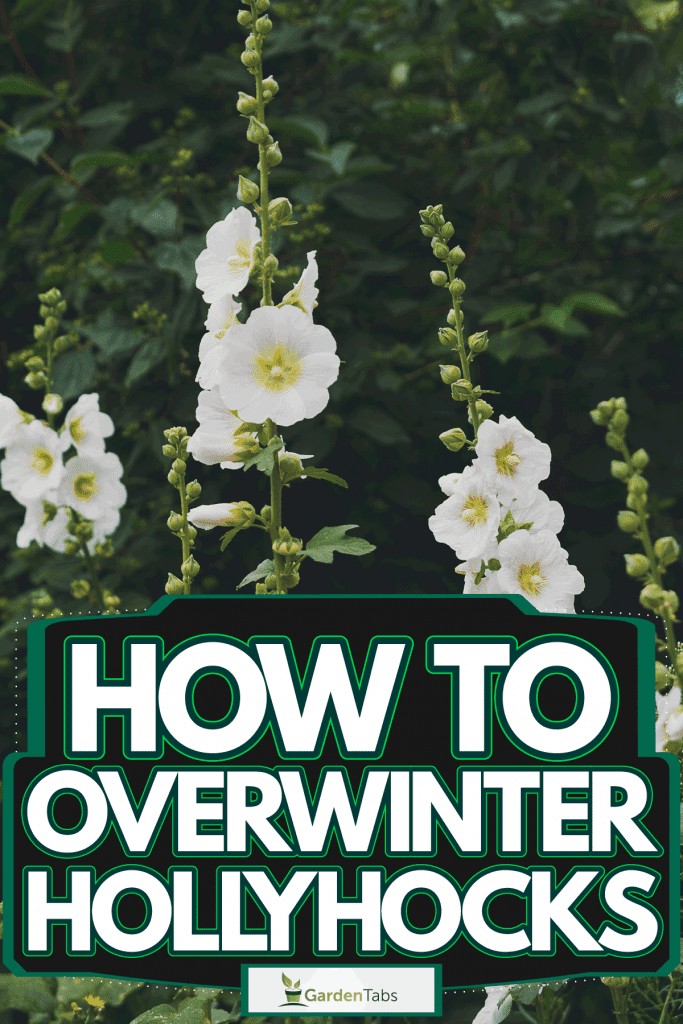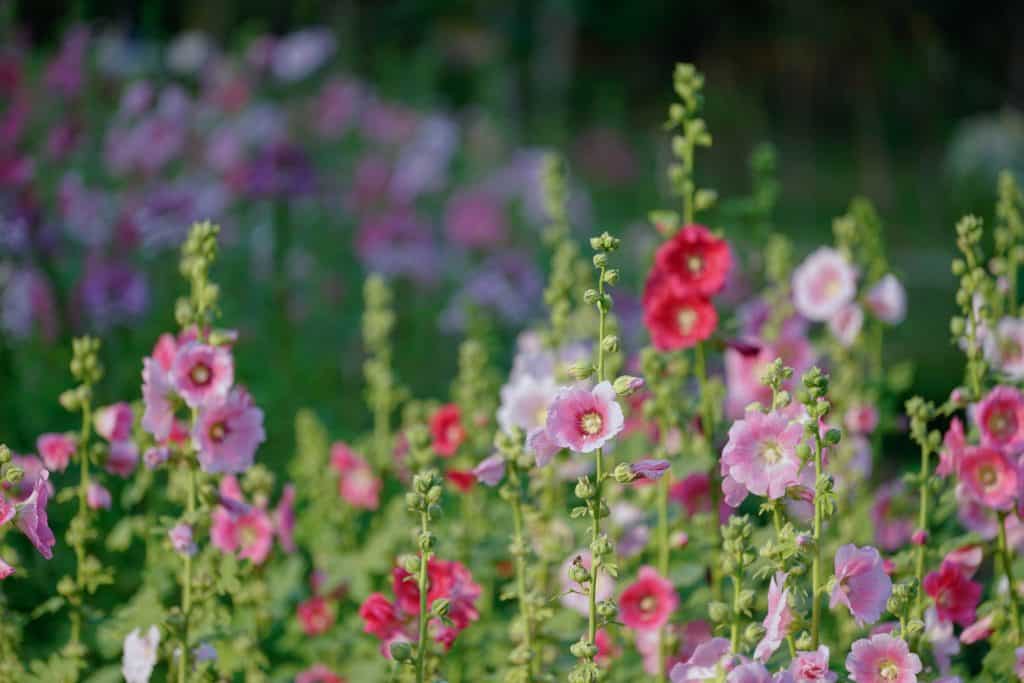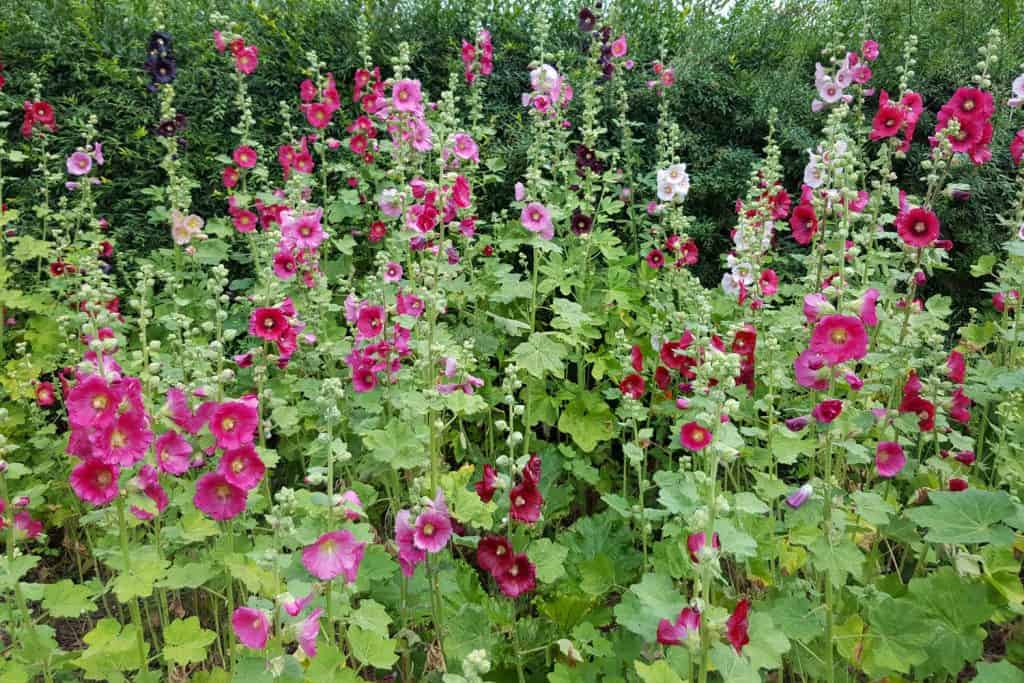Hollyhocks, or Alcea, are annual, biennial, or perennial plants depending on the specific species. These beautiful ornamental plants can be easily grown from seed and attract other beings to your garden. Hollyhocks die back in winter, but you need to protect the roots to ensure you can enjoy their beautiful blooms again in the summer. How do you prepare these plants before the cold comes? We gathered the research to give you this detailed guide on overwintering Hollyhocks and more.
The winter care needed for your Hollyhocks depends on where you live. In any area, it is recommended to cut back stems and leaves before the fall. In environments that reach freezing, you will need to protect the roots of your Hollyhocks by layering organic material over the root zone.
These are the basics for overwintering Hollyhocks. Keep reading as we discuss the preparation required of Hollyhocks for winter in depth. We will answer if these plants can survive frost and if putting Hollyhocks in pots is an option.

How Do You Prepare Hollyhocks For Winter?
After planting Hollyhocks, it takes two years for you to start seeing flowers. The first year you will get vegetative growth that involves fuzzy leaves and no stems or blooms.
The following summer, tall stalks with flared flowers will bloom for multiple weeks. After flowering, these plants will reseed themselves, offering you a lifetime supply of these tall beauties. You'll need to prepare your Hollyhocks for the winter to get them to this blooming period. Let's talk about how this process gets done.
An important part of preparing Hollyhocks for winter is cutting back old stems and leaves. These plants are prone to illness due to fungus, such as rust disease. Removing old foliage will decrease the chances of spores spreading and affecting your plants. Cut the stems back so what's left sits 6 inches above the ground or crown of the plant.

USDA hardiness zones that experience hard freezes require a little extra care for winter prep of Hollyhocks. You will need to cut back the stems and prepare the ground to protect the roots.
You should lay organic material, such as straw, leaves, compost, or mulch over the root zone. This layer should be about 4 inches to 6 inches thick and will keep the roots from freezing. This material can be removed slowly in early Spring.
Read more on our blog post, “30 Tall Thin Plants For Landscaping Your Garden or Backyard”
Can You Put Hollyhocks In Pots?
You can put Hollyhocks in pots. Planting seeds in containers that are kept inside through the worst of frosts is ideal in specific zones. There are some aspects to consider when planting Hollyhocks in pots, and, just as in the ground, you won't see flowers from these plants until the second year.
Hollyhocks need a lot of room. Both their taproots and lateral roots are long and spread wide. The larger the pot and the more space is ideal for these plants. Large barrel-shaped pots offer plenty of space for these plants and their large root systems.
Hollyhocks in pots tend to dry out faster as well. Check your pots daily for soil moisture and keep up with routine watering to keep these plants happy and healthy. The addition of planting stakes can give your Hollyhock extra support to avoid the stem falling over and snapping while in its pot.
You can find natural bamboo plant stakes here on Amazon.
The benefit of potting Hollyhocks is you can quickly move them inside before the worst of the cold. Doing so protects them from the frost and saves you the step of mulching the ground.
It would be best if you still cut back or remove old stems and leaves for potted hollyhocks. Another option is to start Hollyhock seeds inside and overwintering indoors, then transplant your plants to the outside in the spring.
Can Hollyhocks Survive Frost?
Hollyhocks can survive frost with the appropriate care. If you live in an area that experiences freezing temperatures and long Winters, be mindful of where you plant these flowers. Areas of your landscape that are protected from wind and polar vortexes are ideal. In these conditions, you need to be on top of mulching the ground to protect dormant roots.
Do you live in a zone that is in a permafrost state? This means the ground never really thaws. If this is the case, you should opt for potted Hollyhocks, or else they are not likely to survive. In most cases, Hollyhock roots will survive the frost and will have new growth in the next season. However, the frost will damage any flowers or leaves that are not cut back.
Read more on our blog post, “Should You Soak Hollyhock Seeds?”
When Should I Cut Down My Hollyhocks?
Preparation for winter needs to be done in fall, before the first frost. The exact month can vary depending on the climate of where you live. The ideal timing for cutting down, or cutting back, these plants is after their blooming period and before the worst of the cold. However, there are other times that your Hollyhocks will benefit from a trim or pruning.

A defining characteristic of Hollyhocks is how tall they can get. As they get too tall, they can flop over, damaging the steam and hurting your plant. Control the size of your Hollyhock by cutting the stem once they reach about 18 inches tall and once again before they bloom. This practice will ultimately lead to a healthier, more full plant.
If you notice dying or diseased leaves or stems, it is time to cut them down or off. Getting on top of infected leaves and other areas of your Hollyhock straight away will decrease the severity of common fungal infections and other pests. Cut down on disease and promote stored energy in your plant with consistent monitoring and pruning as needed.
Read more on our blog post, “Should You Deadhead Sea Holly?”
What To Do With Hollyhocks When They Have Finished Flowering?

After flowering, you will notice the blooms begin to fade. When you notice this, you can cut off or deadhead your Hollyhock flowers. This process can help your plant focus its energy on creating strong roots. Cutting the flower heads off right away prevents the process of reseeding as well if you are looking for more control of the area.
Perhaps you want your Hollyhocks to reseed. If you want seed heads to form and drop, simply leave the flowers and some stems until the seeds have dropped and prune back after. This will leave you with seeds set for the following spring.
Do Hollyhocks Come Back Every Year?
Hollyhocks often do come back every year, but it is not necessarily the original plant that is returning. Most species of this plant have a lifespan of 2-3 years. However, they are proficient self-seeders. Once you have an established Hollyhock, allow it to drop its seeds every year, and you then have a lifetime supply of these beauties.
There are certain species that are perennials, but the majority of the time, your Hollyhock flowers are biennials. Practices such as deadheading can extend the lifespan of these plants.
Although it is ideal that new plants get started every August or September, so you never miss a year of blooms. Give your plants an extra boost by fertilizing or adding compost in the Spring, before the blooming season.
Concluding Thoughts
Overwintering Hollyhocks takes minimal work compared to other plants that you may have in your landscape. In most cases, pruning back stems and removing any flowers or leaves before the worst of the cold is enough. In more extreme temperatures, such as prolonged freezes, you will need to mulch the ground with organic matter to insulate and protect the dormant roots.
If you have potted plants, simply bring them inside when the temperature begins to drop. Hollyhocks are re-seeders and are often dropping enough to bring you new plants the following year. We hope you found this article helpful when it comes to the Winter care of your Hollyhocks, and you get to see enough of those flame-like blooms this coming season.
Do you have more plants in need of overwintering? Have a look through our blog post, “How To Overwinter Gardenia — In Pots And In Ground.”

